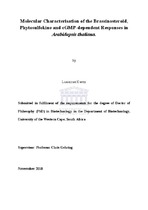| dc.contributor.advisor | Gehring, Chris | |
| dc.contributor.author | Kwezi, Lusisizwe | |
| dc.contributor.other | Dept. of Biotechnology | |
| dc.contributor.other | Faculty of Science | |
| dc.date.accessioned | 2013-10-24T08:01:58Z | |
| dc.date.available | 2011/05/11 10:25 | |
| dc.date.available | 2011/05/11 | |
| dc.date.available | 2013-10-24T08:01:58Z | |
| dc.date.issued | 2010 | |
| dc.identifier.uri | http://hdl.handle.net/11394/2311 | |
| dc.description | Philosophiae Doctor - PhD | en_US |
| dc.description.abstract | In this thesis, we have firstly cloned and expressed the domains that harbours the putative catalytic GC domain in these receptor molecules and demonstrate that these molecules can convert GTP to cGMP in vitro. Secondly, we show that exogenous application of both Phytosulfokine and Brassinosteroid increase changes of intracellular cGMP levels in Arabidopsis mesophyll protoplast demonstrating that these molecules have GC activity in vivo and therefore provide a link as second messenger between the hormones and down-stream responses. In order to elucidate a relationship between the kinase and GC domains of the PSK receptor, we have used the AtPSKR1 receptor as a model and show that it has Serine/Threonine kinase activity using the Ser/Thr peptide 1 as a substrate. In addition, we show that the receptor`s ability to phosphorylate a substrate is affected by the product (cGMP) of its co-domain (GC) and that the receptor autophosphorylates on serine residues and this step was also observed to be affected by cGMP. When Arabidopsis plants are treated with a cell permeable analogue of cGMP, we note that this can affect changes in the phosphoproteome in Arabidopsis and conclude therefore that the cGMP plays a role in kinase-dependent downstream signalling. The obtained results suggest that the receptor molecules investigated here belong to a novel class of GCs that contains both a cytosolic kinase and GC domains, and thus have a domain organisation that is not dissimilar to that of atrial natriuretic peptide receptors NPR1 and NPR2. The findings also strongly suggest that cGMP has a role as a second messenger in both Brassinosteroid and Phytosulfokine signalling. We speculate that other proteins with similar domain organisations may also have dual catalytic activities and that a significant number of GCs, both in plants and animals, remain to be discovered and characterised. | en_US |
| dc.language.iso | en | en_US |
| dc.publisher | University of the Western Cape | en_US |
| dc.subject | Brassinosteroids | en_US |
| dc.subject | Genomics | en_US |
| dc.subject | Genetics | en_US |
| dc.subject | DNA microarrays | en_US |
| dc.subject | Arabidopsis | en_US |
| dc.subject | Arabidopsis thaliana | en_US |
| dc.title | Molecular Characterisation of the Brassinosteroid, Phytosulfokine and cGMP-dependent Responses in Arabidopsis thaliana | en_US |
| dc.type | Thesis | en_US |
| dc.rights.holder | University of the Western Cape | en_US |
| dc.description.country | South Africa | |

